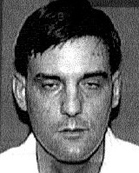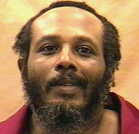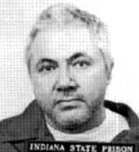
Mugshots from <a href="http://www.Murderpedia.org">Murderpedia.org</a>, except where indicated.
Just how crazy must a person be to be ruled incompetent for execution in the United States? Being profoundly mentally ill is not enough. You have to be deemed legally “insane.”
At trial, the insanity defense generally hinges on a person’s inability to distinguish right from wrong or understand the “nature and quality” of his act. In the context of an impending execution, insanity means you cannot rationally comprehend that you are being put to death as a consequence of the crime you committed.
In 2005, a Texas jury found that Andre Thomas, the subject of my in-depth companion piece (see box below), was not insane at the time of his crime.
To put this in context, consider that Thomas was then, and still is, a delusional paranoid schizophrenic who hears voices—from God, he believes—telling him to do things. He carved out the organs of his four-year-old son, his estranged wife, and her 13-month-old daughter, and took them home in his pockets, believing that this would kill the demons inside them. In the days following his arrest, he insisted to a jailhouse nurse that his victims were still alive.
And that’s not even the weirdest part of the story.
Thomas’ case is on appeal in federal court, and as it stands, the courts cannot even address the question of whether he is competent to be executed until he is about to be. But should someone as obviously crazy as Andre Thomas be facing execution at all? Over the past decade, US courts have barred the death penalty for the intellectually disabled and for juveniles—the Supreme Court found that they have less culpability due to their lower mental functioning and immaturity. Many legal observers believe that barring the death penalty for the severely mentally ill, given their dissociation from reality, is the next frontier in capital jurisprudence.
Over the years, governors from both parties have seen fit to commute the death sentences of profoundly mentally ill prisoners, even in conservative states. But authorities in Texas have shown little mercy: The state Board of Pardons and Paroles has recommended clemency based on mental illness in only one case since 1977, when the death penalty came back into use (see Kelsey Patterson below)—and Gov. Rick Perry denied it.
Patterson is hardly an anomaly, though. Here is a sampling of 13 capital cases in Texas and elsewhere that beg the question: How crazy is too crazy for the ultimate punishment?

Name: Johnny Frank Garrett
State: Texas
Crime: Fatally stabbed a nun in 1981
Punishment: Executed in 1992
Diagnosis: Garrett was a paranoid schizophrenic who firmly believed that lethal injection could not kill him, and that supernatural intervention by his long-dead aunt would counteract the poisons. Even Pope John Paul II called for clemency, but Garrett was put to death nonetheless.

Name: Larry Keith Robison
State: Texas
Crime: Fatally shot and stabbed five people in 1982
Punishment: Executed in 2000
Diagnosis: A paranoid schizophrenic, Robison began hearing voices and acting strangely as a teenager, and he claimed to have secret paranormal mental powers and the ability to read people’s minds and move objects from a distance. He described voices in his head, which came through the clocks in his room, spewing out warnings about Old Testament prophecies of the Apocalypse. Robison interpreted this as a message that he had to liberate as many souls as possible before the liberation of his own. His parents sought help for their son, warning mental-health authorities of Larry’s erratic and increasingly aggressive behavior, but were told that the state could offer him no resources unless he turned violent.

Name: Monty Allen Delk
State: Texas
Crime: Killed a man in 1986
Punishment: Executed in 2002
Diagnosis: Prison mental-health staffers first diagnosed Delk as bipolar and later decided that he was malingering. While in prison, Delk behaved delusionally and claimed to be the president of Kenya and a submarine commander. Asked if he had any last words, he replied, “I am the warden. Get your warden off this gurney and shut up…You are not in America. This is the island of Barbados, people will see you doing this.”

Name: James Blake Colburn
State: Texas
Crime: Tried to rape, and then killed a woman he saw hitchhiking in 1994
Punishment: Executed in 2003
Diagnosis: Colburn was diagnosed as a paranoid schizophrenic at age 17. He was so doped up on anti-psychotic drugs at his trial, appeals lawyers noted, that he snored loudly through his trial—and when he was not medicated, he consumed his own bodily wastes.

Name: Kelsey Patterson
State: Texas
Crime: Randomly shot two people in 1992
Punishment: Executed in 2004
Diagnosis: Patterson was a paranoid schizophrenic who claimed he was controlled by an electronic implant. After fatally shooting a businessman and his secretary for no apparent reason, he went home, stripped to his socks and walked around naked in the streets until the police picked him up. “What are we doing here?” a federal judge reportedly asked the state’s attorney general during an appeal of Patterson’s death sentence. “This is a very sick man.” Patterson was the first and only modern-day case in which the Texas Board of Pardons and Parole has recommended that the governor commute a death sentence based on mental illness, but Gov. Rick Perry denied him clemency. Asked for a final statement, Patterson said: “Statement to what. State what. I am not guilty of the charge of capital murder. Steal me and my family’s money. My truth will always be my truth. There is no kin and no friend; no fear what you do to me. No kin to you undertaker. Murderer…Get my money. Give me my rights. Give me my rights. Give me my rights. Give me my life back.”

Name: Scott Louis Panetti
State: Texas
Crime: Killed his parents-in-law in 1992
Punishment: Awaiting execution
Diagnosis: Schizophrenia and manic depression. Before he was arrested for capital murder, Panetti had been hospitalized for mental illness on 14 occasions. At trial he represented himself clad in a purple cowboy suit. As evidence of his delusional nature, he said he wanted to subpoena Jesus, JFK, and the Pope.

Name: Steven Staley
State: Texas
Crime: Killed a hostage in a failed robbery in 1989
Punishment: Execution stayed in 2012
Diagnosis: Paranoid schizophrenic. In a story for Slate, legal reporter Emily Bazelon lays out Staley’s case history: His mentally ill mother tried to pound a wooden stake through his chest when he was seven. He tried to kill himself as a teenager. According to doctors who have evaluated him on death row, he has “grandiose and paranoid” delusions, believing, for example, that he invented the first car and marketed a character from Star Trek. He also wets himself and smears his feces around the cell. In 2006, after a judge deemed him incompetent for execution, prosecutors sought to have him forcibly medicated so that they could establish his competence. A state court then stayed Staley’s sentence last year without ruling on the legality of using forced medication for this purpose.
Other States

Name: Guy Tobias LeGrande
State: North Carolina
Crime: Killing for hire in 1993
Punishment: Sentenced to death; deemed incompetent in 2008
Diagnosis: LeGrande, who was diagnosed with a delusional disorder, killed the wife of a man who paid him to do it. He believed could communicate with Oprah through his television, and represented himself at trial wearing a Superman T-shirt. He also cursed his jury and called them “Antichrists.” A state court found him incompetent to be executed. He remains in prison.

Name: George Emil Banks
State: Pennsylvania
Crime: Killed 13 people in a shooting spree in 1982
Punishment: Sentenced to death; deemed incompetent in 2010
Diagnosis: Banks, who suffered from a psychotic disorder and thought the government was trying to poison him, believed he was exempt from the death penalty and that his death sentences had been vacated by God, Jesus, and then-president George W. Bush. In May 2010, a lower court deemed him incompetent to be executed. The decision was affirmed by the Pennsylvania Supreme Court in 2011. Banks remains on death row, however.

Name: Calvin Eugene Swann
State: Virginia
Crime: Killed a man during a robbery in 1992
Punishment: Death sentence commuted in 1999
Diagnosis: In his late teens, Swann began talking to animals and speaking in numbers, which led his parents to commit him to a mental institution, the start of a lifetime spent shuffling between institutions and prisons. On the days leading up to his execution, Swann’s only concern seemed to be money for cigarettes. In the end, Gov. Jim Gilmore commuted his sentence to life without parole—which wasn’t a sentencing option at the time of his trial—and quoted prison officials saying Swann’s behavior on death row was “nothing short of bizarre and totally devoid of rationality.” When Swann’s lawyers told him the good news, according to the Washington Post, the prisoner appeared not to understand. He merely asked for a cigarette.

Name: Alexander E. Williams
State: Georgia
Crime: Kidnapped, raped, and killed a teenage girl in Georgia in 1986
Punishment: Death sentence commuted in 2002
Diagnosis: A paranoid schizophrenic, Williams saw little men in his cell, talked to animals, and thought Sigourney Weaver was God. The Georgia Pardons and Parole Board commuted his sentence to life without parole. Nine months later, he hung himself in his cell at the state prison.

Name: Arthur Paul Baird II
State: Indiana
Crime: Killed his wife and parents in Indiana in 1985
Punishment: Death sentence commuted in 2005
Diagnosis: Baird had a long history of mental illness. He claimed he had solved the nation’s debt and was owed a $1 million reward from the government, and that God would turn back time and bring his wife and parents back to life. In commuting Baird’s sentence, Gov. Mitch Daniels recognized the severity of the prisoner’s mental illness, noting that, had the option been available, the jury would have imposed life without parole instead of a death sentence.

Name: Percy Levar Walton
State: Virginia
Crime: Killed three people in 1996
Punishment: Death sentence commuted in 2008
Diagnosis: Walton, a schizophrenic, began exhibiting signs of psychosis during adolescence. In the months following his crime he sat in his cell and in court smiling, laughing, and rocking back and forth. He would say he was Superman and Jesus, and that the Bible was written about him. He believed that his execution would bring him, his grandfather, and his victims back to life. Recognizing that Walton was “seriously mentally impaired,” Gov. Tim Kaine commuted his sentence to life without parole.













